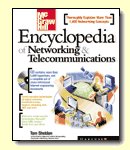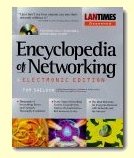|
Site home page
(news and notices)
Get alerts when Linktionary
is updated
Book updates and addendums

Get info about the Encyclopedia of Networking
and Telecommunicatons, 3rd edition (2001)

Download the electronic version of the Encyclopedia
of Networking, 2nd edition (1996). It's free!
Contribute to this site
Electronic licensing info
|
|
Topology
Related Entries Web Links New/Updated Information
Note: Many topics at this site are reduced versions of the text in "The Encyclopedia of Networking and Telecommunications." Search results will not be as extensive as a search of the book's CD-ROM.
A network topology is the physical layout of a network. There are local network topologies and enterprise network or WAN (wide area network) topologies. LAN topologies consist of the designs described below and pictured in the following illustration.
Illustration (see book, page 1257)
- Bus A single trunk cable connects each workstation in a daisy-chain topology. Signals are broadcast to all stations, but packets are received only by the station to which they are addressed. Ethernet implements this topology. A break in the cable affects the entire network. Traditional Ethernet uses this topology
- Star
Workstations attach to hubs and signals are broadcast to all stations or passed from station to station. A break in the cable only affects the attached workstation.
- Star-configured ring
A ring network in which signals are passed from one station to another in a circle. The physical topology is a star in which workstations branch from concentrators or hubs, but the logical topology is a hub. Token ring is an example of this topology.
- Star/bus configuration
A network that has groups of star-configured workstations connected with long linear bus trunks. Ethernet 10Base-T and Fast Ethernet use this topology.
Enterprise networks and wide area networks expand on these topologies as pictured in this illustration:
Illustration (see book, page 1258)
- Ring backbone network A high-speed network that interconnects many lower-speed networks, delivering frames or packets among them. The backbone may be linear, ring, or mesh. An organization may build a backbone network that snakes through a building, or install a hub that has a high-speed "collapsed backbone" inside a box.
- Switched core backbone
The switched core is usually an ATM switch or mesh of ATM switches that provide virtual circuits among all the interconnected networks. Service providers and Internet exchanges have used this configuration to interconnect the different networks that make up the Internet.
- Mesh network
A network consisting of interconnected routers and/or switches with multiple paths and the ability to route around failed links. The Internet is a mesh network.
- Interlinked star
This is a hierarchical topology that provides redundant links and high- availability for private WANs and service provider networks. Each data center has links to the remote sites, but the backup data links may be in standby mode only (i.e., dial-on- demand). The data centers are interconnected and data is replicated across the link.
Copyright (c) 2001 Tom Sheldon and Big Sur Multimedia.
All rights reserved under Pan American and International copyright conventions.

|

